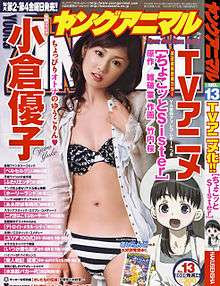Young Animal (magazine)
 July 14, 2006 issue of Young Animal | |
| Categories | Seinen manga[1][2] |
|---|---|
| Frequency | Bimonthly |
| Circulation |
103,500[2] (July-September, 2016) |
| Year founded |
1989 (as Animal House) 1992 (renamed to Young Animal) |
| Company | Hakusensha |
| Country | Japan |
| Based in | Tokyo |
| Language | Japanese |
| Website | http://www.younganimal.com |
Young Animal (ヤングアニマル Yangu Animaru) is a magazine in Tokyo, Japan, that features seinen manga and scantily clad girls.
History and profile
It was first issued in 1989 as Animal House and was renamed Young Animal in 1992. It may have been a reboot of an earlier Hakusensha shōnen magazine entitled Gekkan Shōnen Jets (launched in 1981) which was discontinued in the late 1980s.[3][4] The magazine is published by Hakusensha and issued on the second and fourth Fridays of each month in saddle-stapled B5 format, selling for 460 yen. The headquarters of the magazine is in Tokyo.[5]
A typical issue consists of about 300 black and white pulp pages of comics wrapped in about 20 slick pages of color pinup photos of teenage girls in bikinis (generally pop stars and gravure idols). Advertising (other than house ads for Hakusensha) appears only in the form of a few ads in the back pages and on the inside and back covers. As of 2015, circulation is approximately 119,000 copies.[6] Each issue features about 15 different stories, mostly serial stories tending toward sexy romantic comedy, fantasy, and epic adventure, with a number of humorous "4-koma" or 4-panel gag strips.
Popular long-running series currently appearing in Young Animal include the medieval dark fantasy adventure Berserk and the modern day married-life sex comedy Futari Ecchi (both over 300 chapters as of 2010). A number of Young Animal manga series have been adapted as anime.
Manga artists and series featured in Young Animal
(Names are in alphabetical order, family name shown last)
- Ryuta Amazume
- Nana to Kaoru (2008-2016) complete
- Hikaru Asada and Takahiro Seguchi
- Sickness Unto Death (2010) complete
- Kou Fumizuki
- Ai Yori Aoshi (1998–2005) complete
- Umi no Misaki (2007–2014) complete
- Boku to Rune to Aoarashi (October 2015–October 2016) complete
- Shigemitsu Harada
- Yuria 100 Shiki (2006–2010) complete
- Masao Hiratsuka and Kazuyoshi Takeda
- Peleliu: Rakuen no Guernica (2016–ongoing)
- Sora Inoue
- Mai Ball! (2012-ongoing)
- Hiroshi Itaba
- Mouse (story by Satoru Akahori) (2000–2004) complete
- Katsu Aki
- Angel Hard
- Futari Ecchi (Step Up Love Story; US: Manga Sutra) (1997–ongoing)
- Futari Ecchi for Ladies
- My Silver-Colored House
- Show
- Kanji Kawashita
- Ateya no Tsubaki (2008-ongoing)
- Kentaro Miura
- Berserk (1989–ongoing)
- Giganto Makhia (2013-2014)
- Japan (1992 manga) (written by Buronson)
- Tomochika Miyano
- Yubisaki Milk Tea (2003–2010) complete
- Kōji Mori
- Holyland (2000-2008) complete
- Jisatsutō (Suicide Island) (2008-2016) complete
- Ashita Morimi
- This Ugly Yet Beautiful World (story by Gainax) (2004–2005) complete
- Nanki Satō and Akira Kiduki
- Usotsuki Paradox (2009–2012) complete
- Yokusaru Shibata
- Air Master (1997–2006) complete
- Naoki Shigeno
- Nobunaga no Shinobi (2008–ongoing)
- Tarō Shinonome
- KimiKiss: Various Heroines (2006–2009) complete
- Amagami: Precious Diary (2009–2010) complete
- Kaoru Shintani
- Buttobi CPU (US: I Dream of Mimi) (1993–1997) complete
- Izumi Takemoto
- Twinkle Star Nonnonzie
- Sakura Takeuchi
- Chocotto Sister (story by Go Zappa) (2003–2007) complete
- Yutaka Tanaka
- Ai-Ren (1991–2002)
- Chica Umino
- March Comes in like a Lion (Sangatsu no Lion) (2007–ongoing)
- Kiminori Wakasugi
- Detroit Metal City (2005–2010) complete
- Makoto Yotsuba and Miyū (story by Ryo Mizuno)
- Grancrest Senki (Record of Grancrest War) (2016–ongoing)
References
- ↑ Thompson, Jason (2007). Manga: The Complete Guide. Del Rey Books. p. xxiii-xxiv. ISBN 978-0-345-48590-8.
- 1 2 "Men's Manga" (in Japanese). Japanese Magazine Publishers Association. September 2016. Retrieved November 6, 2016.
- ↑ Hakusensha History
- ↑ Hakusensha Magazines
- ↑ John E. Ingulsrud; Kate Allen (3 February 2010). Reading Japan Cool: Patterns of Manga Literacy and Discourse. Lexington Books. p. 21. ISBN 978-0-7391-3507-5. Retrieved 30 October 2016.
- ↑ Japan Magazine Publishers Association Magazine Data June 2015. Retrieved Oct. 28, 2015.
External links
- Young Animal Official website (Japanese)